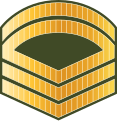Top Qs
Timeline
Chat
Perspective
Sergeant first class
Non-commissioned officer military rank From Wikipedia, the free encyclopedia
Remove ads
Sergeant First Class (SFC) is typically a senior non-commissioned officer rank, used in many countries.
This article has multiple issues. Please help improve it or discuss these issues on the talk page. (Learn how and when to remove these messages)
|
Remove ads
United States
Summarize
Perspective
Sergeant First Class (SFC) is the seventh enlisted rank (E-7) in the U.S. Army, ranking above staff sergeant (E-6) and below master sergeant and first sergeant (E-8), and is the first non-commissioned officer rank designated as a senior non-commissioned officer (SNCO).
A sergeant first class is typically assigned as a platoon sergeant at the company level or battalion operations non-commissioned officer in charge at the battalion level, but may also hold other positions depending on the type of unit. In a combat arms role, a sergeant first class is typically second in charge (under an officer, typically a second lieutenant, serving as the platoon leader) of from 14 soldiers and four tanks in an armor platoon to 36 soldiers and four squads in a rifle platoon. A sergeant first class's primary responsibilities are tactical logistics, tactical casualty evacuations, and serving as the senior tactical adviser to the platoon leader. Sergeant first class replaced the rank of technical sergeant in 1948. (However, the U.S. Air Force, which separated from the Army in 1947, retained the rank of technical sergeant, and the U.S. Marine Corps had the rank of technical sergeant until 1959.) Sergeants first class are selected by a centralized promotion system.
The rank title of sergeant first class (SFC) existed in the Army from 1890 [1] until 1920 when it was eliminated in an army-wide simplification of enlisted ranks which had grown into a system containing 128 different rank insignia. The rank of SFC was used in several technical branches such as the Army Medical Department and in the Ordnance, Signal, and Quartermaster Corps and was equivalent to the field service ranks at the company/battery/troop "staff" NCO level, such as color sergeant, supply sergeant, or radio sergeant. The Army restored the rank of SFC in 1948 when it replaced technical sergeant.[2]
Remove ads
Gallery
See also
References
Wikiwand - on
Seamless Wikipedia browsing. On steroids.
Remove ads






